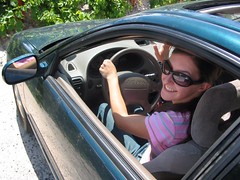are those your flagella, or are you just happy to see me?
for thousands of years, people have been coaxing other creatures into doing chores. Now, a team of scientists has microsized the strategy. they've devised a way to make single-cell algae bear loads over distances of several centimeters—a tactic that the researchers say could prove useful in tiny machines.
 |
ON FOR THE LONG HAUL. Beating its twin flagella, this algal cell lugs a polystyrene bead through water. |
algae and other single-celled organisms power their movements with molecular motors. scientists have long coveted these motors for use in micromachinery, notes chemist douglas b. weibel of harvard university.
however, pulling the devices from cells and modifying them to work with lab-derived machinery would require sophisticated bioengineering techniques. to avoid that hurdle, weibel and other scientists led by george m. whitesides of harvard tried something simpler. the team recruited entire organisms, leaving their motors in place.
the researchers harnessed algae of the species Chlamydomonas reinhardtii to transport tiny beads. first, the scientists engineered a molecule to have two sticky ends and a middle section that breaks apart when exposed to ultraviolet (UV) rays. one end of the molecule adheres to polystyrene, and the other to an alga's cell wall. the team used the engineered molecule to coat beads made of polystyrene plastic.
the algae, which convert sunlight to biochemical energy, tend to travel toward visible light. whitesides' team placed a few algae at one end of a thin, straight track cut into a polymer-coated glass plate. a pile of beads sat at the midpoint of the track.
when the researchers shined a low-intensity visible light from the end of the track opposite the algae, the organisms swam toward the light, each cell beating its two flagella breaststroke-style. when the algae reached the midpoint, they collided with the beads. the sticky molecules linked one or two beads to each cell, and the cells continued moving toward the light.
as long as the beads didn't adhere near an alga's flagella, each cell could haul a load of its own weight with little slowdown. "these cells are workhorses. they can really pull," says weibel.
when the cells reached their destination—swimming as much as 20 centimeters, or 20,000 of their own body lengths, from start to finish—the researchers flashed UV light to break the chemical bond that attached the beads. visible light shining from the track's opposite end coaxed the organisms back to the start.
christen brownlee
science news










